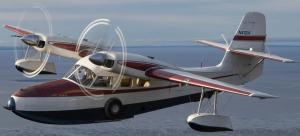
Magnum Widgeon (Dietmar Schreiber)
The Grumman Magnum Widgeon
by Burke Mees
Published 9 Nov 2020
 Magnum Widgeon (Dietmar Schreiber) |
When I was growing up in the Midwest, I was the guy driving an old VW station wagon while the cool kids were driving the 1970s muscle cars that were still in everyday use. Iíve always been a practical person with modest tastes, but apparently that was just because I didnít know any better. That changed last year when I made a 3,000-mile ferry flight in a Magnum Widgeon. Itís an outlandish airplane and I felt like a teenager whoíd been given the keys to a Dodge Demon. All that rational pragmatism went right out the window. I got off the farm, pulled out into the fast lane and had a wild fling with speed and raw horsepower that I wonít soon forget. This is an airplane worth writing about, even if itís hard to put into words. |
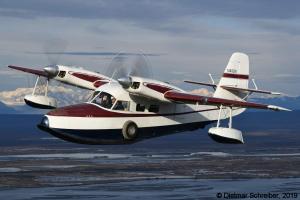 Magnum Widgeon (Dietmar Schreiber) |
What exactly is the Magnum Widgeon? It is an extravagant re-make of an old classic. The original Grumman Widgeon was like the 32 Ford Roadster; it was modestly sporty in its time but it went on to become a platform for hotrod conversions. In this case, the original inverted inline Ranger engines that came from the golden age of antiques gave way to a package of thoroughly modern counter-rotating turbocharged Lycoming TIO-540s.
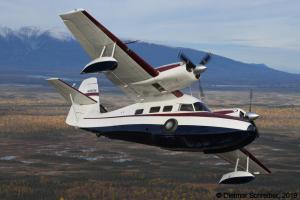 Magnum Widgeon (Dietmar Schreiber) |
Airplanes reflect the era that produced them, and the Magnum conversion came about in 1989. That was when Ronald Reagan was President, Eddie Van Halen was playing on the radio, the Berlin Wall was coming down, and conditions were right to make the Widgeon Great Again. The airplane is a work of pure 1980s Americana. It exemplifies our national inclination for highly engineered raw power. It reveals the disdain for convention that underlies American life. It expresses our disregard for limits and our propensity to overdo things with a straight face. During that time the term "Magnum" had been popularized by Inspector Dirty Harry Callahan, and I can hear his raspy voice saying “This is the most powerful version of the Grumman Widgeon in existence, what do you think of that, punk?”
How did something like this come about? Let's start at the beginning. The original Widgeon (Type Certificate Data Sheet) first came out in 1941, back when the Japanese were making plans to bomb Pearl Harbor and Grumman was making carrier-based fighter planes. I suspect this small seaplane was probably just an incidental side-project, but it took on the prevailing themes around the shop. It was built to have a strong airframe, effective flight controls and the same wing as the Grumman F4F Wildcat. Those same airfoil sections, the NACA 23015 at the root and NACA 23009 outboard, were used on the Grumman F4U Corsair and TBM Avenger. It was a wing that could go fast, maneuver in combat and fly well enough at slow speeds to land on an aircraft carrier.
The G44 was sporty from the beginning, but in terms of nimble and responsive handling, not in terms of power. For engines it had anemic 200 horsepower inverted six-cylinder Rangers that were already old technology. Airplanes with obsolete engines usually fade into obscurity, and that might have been the case here if a series of more modern engine conversions hadn’t extended the Widgeon’s relevance into the 21st century.
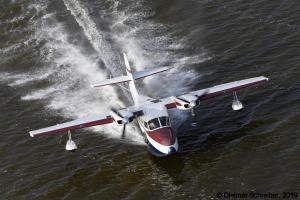 Magnum Widgeon (Dietmar Schreiber) |
The Widgeon airframe could accept several of the new engines that came out after the war, and at first things proceeded in a reasonable manner. For example the Continental O-470 was a good match for the airframe and might be about what Grumman would have used in the first place if it had existed back then. But why stop there? The impressive torque of the geared Lycoming GO-480 was more of a good thing and you can’t help but to appreciate that. That should have been enough, but American tastes in internal combustion tend to be extravagant and insatiable. How much is too much? The Magnum conversion was apparently meant to explore that question.
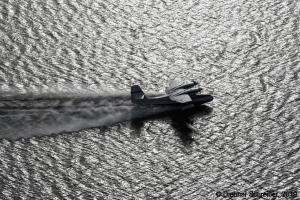 Magnum Widgeon (Dietmar Schreiber) |
The TIO-540s are fire-breathing crucibles of compressed plasma fury and they brought about the complete transformation of this airplane. The original Widgeon is sporty in the tradition of the four-cylinder British sport scar with rack and pinion steering. The Magnum Widgeon is sporty in the manner of a heavy rubber-burning muscle car from the American era of hot metal and chrome.
Whose idea was this anyway? After all, history doesn’t shape itself; rather it turns on the actions of great men. In this case, the man behind the Magnum Conversion was Dennis Burke, and the small world being what it is, it wasn’t hard to ask around and get his phone number.
Dennis recounted that the engineer behind the project was Ned Rice, who was a serious figure in post-war engine design. Ned began his aviation career flying the Grumman Hellcat in the Pacific during World War II, after which he went on to become the Director of Research for the Pratt & Whitney Aircraft Engine Division. His career included working on the J58 engine that propelled the SR-71 to Mach 3, and while he never said much about it, word is that Ned also worked on the 1950s project to develop a nuclear-powered turbine aircraft engine. Those were exuberant times in aviation and Ned had apparently made a career of working on outlandish propulsion systems. After he retired, the Magnum Widgeon project was a natural segue.
In a way Ned may have been getting back to his roots by bringing the Widgeon’s horsepower-to-weight ratio roughly up to the level of the Hellcat that he had flown at the beginning of his career. The initial plan was to convert a single airplane, but they ended up getting an STC and converted a total of six. With that, Dennis and Ned established a legacy that made the world a better place.
The Airplane
But enough about old history, what about the airplane itself? After all, we’re not talking about a museum exhibit; this is a visceral beast that lives in the present. Obviously the airplane’s trademark feature is power. In measurable terms it has a full 50% more horsepower than the original, but the increase in badass factor is exponential. Even so, the engines aren’t being unleashed to their full potential, and the 300 horsepower is a de-rated number; at full throttle the TIO-540-J2B engines produce 350 horsepower. The method of de-rate was just to re-draw the manifold pressure gage redline mark at the 38.5 inHgA with no other mechanical modifications and it's up to you to not exceed that on takeoff. That means that it’s possible to fully open the throttles and let the density controller set the manifold pressure to 43 inHgA. It’s not necessarily legal or recommended to use the full horsepower, but what can I say, it’s there. Extenuating circumstances being what they are, I suppose it never hurts to have a "war power" setting to hold in reserve.
What does this much power look like in the airplane? It doesn’t waste any time getting off the water, and when it does it climbs at rates not normally associated with seaplanes. With both engines, running it will climb all the way to its fight-tested service ceiling of 24,000 feet, although I hear it gets a little sensitive up there in the thin air. Dennis reports that 15,000 to 18,000 feet is the sweet-spot for a high altitude cruise. If only one engine is running, it will climb up to a flight-tested single-engine service ceiling of 13,600 feet.
The Magnum Widgeon has the full performance package, so you’d only expect some platinum-level extras, such as counter-rotating propellers. Different airplanes have counter-rotating propellers for different reasons; the Piper Navajo has inward-rotating props to eliminate the critical engine, the P-38 has outward rotating props to provide a more steady gun platform and a hull seaplane has counter-rotating props to eliminate torque roll on takeoff.
When you add power for takeoff in a standard Grumman, the torque form the right turning props rolls the airplane onto the left wing float. This introduces certain asymmetries, most notably increasing the spray damage to the left propeller. There are various techniques to overcome this torque roll and keep the wings level. For example, you can start the takeoff with full right aileron, or start the takeoff with just enough left crosswind to counter the roll, or enlist the help of centrifugal force by starting the takeoff with a gentle turn to the left, or some combination of these. However you choose to deal with this torque roll, the task adds to your workload at an already busy time. With counter-rotating props, the issue just disappears --- torque from the two propellers cancel each other out and the wings are easily held level on takeoff with minimum effort. Torque roll n a standard airplane is something you just get used to and it’s not until it’s gone that you realize what a nuisance it was.
All this extravagance comes at a cost. I’m not talking about money, but rather the universal aerodynamic currency of weight. The original Ranger airplane was in the featherweight class, the post-war conversions got heavier as they got more powerful, and the Magnum airplane is probably the most bloated of them all.
The airplane’s heavy weight isn’t an issue when it comes to performance, but the Magnum Widgeon pushes the displacement limits for a hull that was originally designed to ride higher in the water. The heavy, forward-leaning airplane rides low to the point that water sometimes washes over the bow on idle taxi. The increased displacement also seems to make it especially sensitive to porpoising on takeoff, although it gets off the water so fast there isn’t a lot of time to get in trouble. As is the case with Widgeons in general, if you use good technique it handles very nicely on takeoff and landing.
The Magnum Widgeon is a hands-on airplane and the sensitive controls constantly require slight adjustments with a light touch. You also have some flight engineer duties ‑ monitoring the turbine inlet temperatures, fuel flows and cylinder head temperatures, making ongoing small adjustments to the throttles, mixtures, cowl flaps to keep everything exactly where it should be. In the age of technology and automation, there’s nothing wrong with being engaged with the airplane and the Widgeon insists on that.
The Twist
So far I’ve described the Magnum Widgeon in terms of its garish excess, but there’s a twist to the story. It turns out this airplane is good for more than just amusing the crowds, it’s also an immensely practical cruiser in its natural habitat. The airplane’s speed, range and multiengine reliability make it perfectly equipped for safe, reliable travel over long distance of inhospitable Alaskan terrain. That became apparent when I found myself flying under a low ceiling over the windblown high-seas of Stephen’s Passage, then when rounding Cape Spencer with the large surf smashing onto jagged rocks below, and again when flying through the Fairweather Trench above gaping crevasses of glacial ice. The Magnum does this with ease and complete indifference to the prospect of an engine failure. If you’re flying low over an un-landable surface and the engine quits, you can feather the propeller, climb up to 13,600 feet and consider your options from there.
The Magnum Widgeon burns a lot of gas to provide these capabilities, but there’s more to that story as well. Flying low and leaning on the rich side of peak I was using 36 gallons per hour to get 140 knots, but it doesn’t have to be that way.
If you’re open to using non-traditional seaplane cruising altitudes, there’s some efficiency to be gained by putting those turbochargers to good use higher up in the rarified air. The charts show the best-range occurs at about 15,000 feet.
As for leaning, some of the TIO-540 journeymen out there make a compelling argument for flying lean-of-peak provided that you have the proper injectors and instrumentation, which this airplane does have. In that case you can get the same performance with fuel flows in the neighborhood of 28 gallons per hour, and that changes everything. The lean-of-peak topic tends to be a matter of religious conviction on both sides of the debate and I’ve received hate mail for even mentioning it. Follow your conscience on that.
In an airplane like this, fuel efficiency isn’t so much about saving money as it is about expanding capabilities. Anything you do to improve gas mileage extends your range, allows you to carry more weight, and generally expands what the airplane can do.
The capabilities of the Magnum Widgeon might seem excessive in a less demanding environment, but they serve a purpose when it comes to the long distances and inhospitable terrain of Coastal Alaska. In this case, the Magnum Widgeon isn’t so much extravagant as it’s the right tool for the right job. That illustrates a particular trait of the American character, that our forays into excess ultimately find practical applications.
End of the Road?
Is the Magnum Widgeon the final say in the long story of re-imagining a modest design from 1941? In a sane world that would be the case, but given the expansive nature of the American temperament, it would be foolish to assume there are any limits. Someone may yet come up with something more outrageous, like a turbine conversion that whines like a screaming banshee, or rocket engines that propel those Wildcat wings to their full potential. Until that happens the Magnum will be the Dodge Demon of the Widgeon lineup.
A while back in the course of idle conversation, someone asked me if I could fly any airplane at all, what would it be? I wasn’t expecting the question, but there was no hesitation in my answer. From someplace deep within my psyche I heard myself reply that it would be a Goodyear F2G Super Corsair with the 3,000 horsepower, 28 cylinder Pratt & Whitney R-4360 radial engine. Not because I expect its a great airplane, but because its an over-the-top expression of mechanical and aerodynamic extravagance; because sitting behind four rows of corncob cylinders appeals to my American DNA. I’m pretty sure I’ll never have that opportunity, but if I confine my fantasies to a slightly more modest scale, then I’ve found something similar in the Magnum Widgeon. Until I get my hands on a Super Corsair, I’ll be content with having spent some time in this.
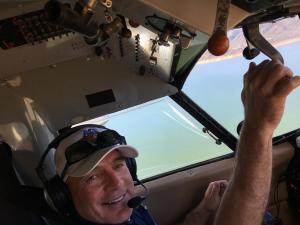 |
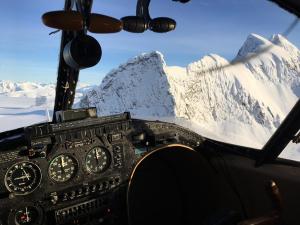 |
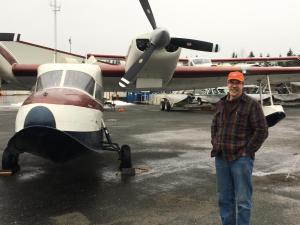 |
 |
| Owner Mike Bergt at the Controls | This is what it is all about! | Author with the Magnum Widgeon | If you fly in Alaska... |
Sidebar: The Widgeon the Never Was
When it comes to airplane reviews, I normally write about real airplanes that actually exist, but in this case I’ll review a hypothetical airplane on the basis that it should exist. This is about one of the few plausible engine conversions that hasn’t been done on the Grumman Widgeon.
The history of Widgeon conversions has been a one-way trajectory of increasing horsepower and gross weights that culminated in the Magnum conversion. While I like what has come of that, I’m surprised that no-one has modernized the airplane in a way that preserves its original character as a modestly powered featherweight. The Ranger Widgeon is a beautiful flying airplane and while those old engines aren’t practical for everyday use, there’s no reason you can’t replace them with comparably sized modern engines that would leave the airplane’s original personality intact. For example installing 200 horsepower Lycoming IO-360s would modernize the airplane without changing the horsepower or altering the airplane’s amiable nature. It would be a great addition to the Widgeon lineup.
I can say this idea is pure genius because it wasn’t mine. Dave Clum mentioned it in casual conversation and it turns out that his uncle had set out to do this conversion but never completed it. The more I thought about it, the more I liked the idea and I gave some serious consideration of how it would work.
The original Ranger Widgeon is light, and this conversion would stay that way. With no change in horsepower, the original 4,500 lb gross weight would remain in place, and unlike other conversions there would be no need to strengthen the airframe. You’d build it from an un-modified Ranger airframe with the fabric wing and flaps.
To avoid re-inventing the wheel, most of the Widgeon conversions steal a complete engine/cowling assembly from another airplane, for example the Magnum conversion got these from the Piper PA-31 Navajo. A short search for an existing 200 hp IO-360 cowling installation takes us to the Piper PA-32-200 Seneca. Since the Seneca has counter-rotating engines, this conversion would have the good handling you get when torque roll isn’t a factor.
So far we’ve kept power and weight the same, but there’s still some opportunity to increase the airplane’s capabilities. The original Ranger airplane had non-feathering props, and obviously the IO-360 comes with full-feathering capability. That is transformative in itself, but let’s consider taking things a step farther; the IO-360 can be outfitted with the truly modern composite MT prop. This saves some more weight, but the exciting thing is that the MT prop is available with a reverse range. This modest conversion could have the gold standard of seaplane propulsion ‑ counter-rotating, fully feathering, reversible props. The airplane would be fully maneuverable on the water with any combination of forward and reverse thrust available. I’ve seen this first hand in the Gweduck and the Albatross and it allows you to do some impressive things.
The IO-360 Widgeon wouldn’t have the muscular nature of the more powerful Widgeons, but it would be a reliable airplane with all the charm of the original. As a twin, it would probably be capable of sustained single-engine fight at light weights, but with heavier loads it would drift down on one engine, which is the case for most piston-twin seaplanes. It would burn 20 gallons per hour, which would give it a five-hour endurance with the original standard tanks. It would be a good light duty personal airplane, but it would make an excellent multi-engine-seaplane trainer.
A good training airplane directs the student’s attention to the relevant topics in the checkout. With no water rudder, the trainee develops the flying-boat skill of maneuvering on the water with well-timed differential power inputs. The non-steerable free-castoring tailwheel provides an introduction to the ground handling characteristics of the old twins. The airplane’s inherently twitchy hull highlights the topic of pitch stability in hull seaplanes and forces the student to perfect the precise attitude management that is appropriate to them. The airplane’s small single-engine performance margins demand some finesse in single-engine flight and the IO-360 is suitably rugged that simulating engine failures isn’t prohibitively abusive. By its very nature, this airplane would have the necessary characteristics to effectively convey the fundamental flying boat topics to students. I could see myself instructing in this airplane.
What would we call it? Maybe the Featherweight Widgeon, the Nouveau Retro, or the G44-360. Regardless, I think it would be a great airplane and the fact that it doesn’t exist is a small detail. If someone corrects that oversight, I think it would bring the Widgeon lineup to completion.